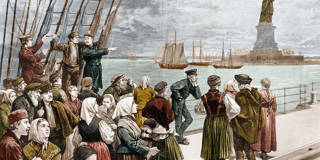Wars and natural disasters have always forced people to cross political borders to seek safety and a better life. But whether they are well-received when they reach their destination depends on a confluence of political, social, economic, and geographic factors.
LONDON – Forced to choose a single factor driving the development of human societies, students of world history would be hard pressed to find a better candidate than migration. In The Unsettling of Europe, the University of Manchester historian Peter Gatrell suggests that the periods when societies have not been “unsettled” by migration are even shorter and rarer than the intervals between wars.
Of course, war itself has been a major driver of migration throughout history. Within living memory, however, the relationship between the two has changed. The archetype of conquering hordes seeking new lands for settlement and exploitation (with the current inhabitants massacred, expelled, or enslaved) has given way to a pattern of mass displacement as a byproduct of larger conflicts.
In Gatrell’s comprehensive, fascinating, and deeply humane history, the conflict in question is World War II. But armed conflicts remain the single most powerful cause of refugee flows around the world, affecting countries of origin and destination alike. And in The Wealth of Refugees, the University of Oxford’s Alexander Betts proposes an impressively coherent and thoroughly articulated “refugee economics” through which to understand the implications of human displacement.

Peter Gatrell, The Unsettling of Europe: The Great Migration, 1945 to the Present, Allen Lane, 2019.
LONDON – Forced to choose a single factor driving the development of human societies, students of world history would be hard pressed to find a better candidate than migration. In The Unsettling of Europe, the University of Manchester historian Peter Gatrell suggests that the periods when societies have not been “unsettled” by migration are even shorter and rarer than the intervals between wars.
Of course, war itself has been a major driver of migration throughout history. Within living memory, however, the relationship between the two has changed. The archetype of conquering hordes seeking new lands for settlement and exploitation (with the current inhabitants massacred, expelled, or enslaved) has given way to a pattern of mass displacement as a byproduct of larger conflicts.
In Gatrell’s comprehensive, fascinating, and deeply humane history, the conflict in question is World War II. But armed conflicts remain the single most powerful cause of refugee flows around the world, affecting countries of origin and destination alike. And in The Wealth of Refugees, the University of Oxford’s Alexander Betts proposes an impressively coherent and thoroughly articulated “refugee economics” through which to understand the implications of human displacement.